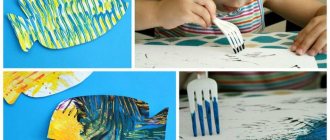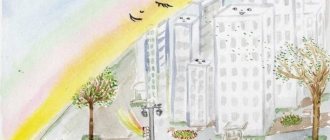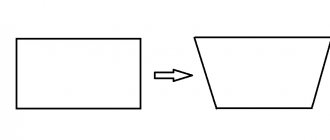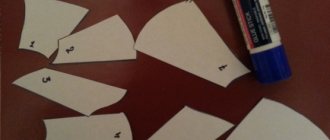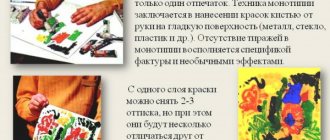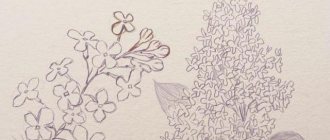Preview:
Drawing lesson for the senior group.
“Decorative drawing based on Dymkovo painting.”
Educational areas: Artistic and aesthetic development.
Cognitive development. Speech development.
Type: Integrated organized joint educational
Specific types of children's activities:
Goal: To teach children to decorate the silhouettes of products with elements of Dymkovo
painting, choosing colors when creating a pattern. Generate interest
- Objectives: To develop children's creativity, sense of color, aesthetic sense, hand motor skills, the ability to highlight beautiful works, the ability to listen carefully to the teacher and answer questions.
- Continue to introduce children to folk arts and crafts (painting based on the Dymkovo toy). Strengthen children's ability to draw the simplest elements of Dymkovo painting (circles, stripes, wavy lines). Select paints (combination of colors so that the toy is bright and elegant). Practice drawing circles with continuous lines with the entire bristle of the brush, rings in one circular motion, drawing dots and dashes with the end brushes
- To cultivate neatness, aesthetic taste, love for Russian applied art, the desire to do something ourselves, adopting simple techniques from folk craftsmen. To cultivate respect for the work of folk craftsmen and admiration for their creativity.
- Learn on your own, create a pattern on a product of a new shape from familiar elements, place it near the frill in accordance with the shape of the skirt or dress.
- Story.
- Looking at albums and illustrations of Dymkovo toys.
- Conversation.
- Independent work.
- Physical education minute.
- Summing up (examining the drawings and describing them by children). Emphasize that they are bright, elegant, and varied. Induce a good mood from the work done.
Equipment and materials: Drawings of Dymkovo toys, pictures with elements of the Dymkovo pattern; samples of Dymkovo toys; watercolor paints, brushes, water, napkins, ready-made template drawings of the Dymkovo young lady, calm classical music.
Preliminary work: Teacher’s story, looking at albums, paintings about Dymkovo toys; conversations; clay modeling of Dymkovo toys; coloring coloring books, talking about the Dymkovo toy.
Educator: Today, children, I invite you to the gallery of drawings of the Dymkovo toy. Look how beautiful it is here! And how many different young ladies! Let's look at them. (Children independently examine toys painted in the style of Mist). They are all so bright, beautiful and very different. But they also have something in common! Guys, think and tell me what are the names of all these toys?
Educator: Why are they called that?
2. Main part.
“Far, far away, behind dense forests, behind green fields, on the banks of a blue river there stood a large village. Every morning people got up, lit the stoves, and blue smoke curled out of the chimneys of their houses. There were many houses in the village. So they called that village Dymkovo. Cheerful and mischievous people lived in that village. They loved to sculpt funny, bright, colorful toys and whistles. They will make a lot of them over the long winter. And when the golden spring sun rises in the sky, the snow runs away from the fields, cheerful people bring out their cheerful toys and let's whistle - drive away winter, glorify spring.
Funny toys were sold in different cities and villages. And after this name, the village and toys began to be called Dymkovo.
Educator: What color are Dymkovo toys?
Children: (Always only white).
Educator: What are the patterns on Dymkovo toys?
Children: (Straight line, wavy line, dot, circle, ring, cage, grid).
Educator: Which color is more? What colors are used?
— What techniques are used to make the patterns?
Children: (By dipping, the end of the brush, brush flat on the pile).
- Look at these young ladies: how are they similar to each other?
Children: (They all have wide dresses, skirts, aprons, beautifully decorated).
Educator: Correct! But these dresses remained white! They are offended and stand on the side. Let's help the young ladies and paint their dresses. Let them also stand proudly at this exhibition, and be glad that they, too, were decorated with beautiful colors. Try to make it bright and elegant. Don’t forget: we draw the lines with the tip of the brush, and apply patterns on the circles only after the circles have dried.
- Sit down more comfortably, let's start working.
During independent work, the teacher keeps all the children in sight, helps those who have difficulty creating a composition, monitors the landing, and the technique of performing the work.
After 10 minutes of independent work - a physical education minute.
We tried to draw (arms to the sides)
It was difficult not to get tired (torso bends to the sides)
We'll rest a little (sit down, hands forward)
Let's start drawing again (stand up, put your hands down)
- Now finish your work, finish drawing the patterns, and then we’ll see your drawings.
To summarize, the teacher hangs up all the drawings, offers to choose the most elegant young ladies and answer the questions:
- What job did you like best? Why?
- What did you like most here?
- What's special about this job?
- How is this job different from others?
Well done, everyone tried to create new beautiful Dymkovo patterns. The lesson is over.
Groups: Shadrina N.V.
Master class on painting the Dymkovo lady
Let's look at the painting of the colorful Dymkovo lady using children's works as an example. In this case, you can take not clay, but plasticine, which is more accessible and comfortable for the child. To work you will need plasticine, a modeling board, stacks, a plastic bottle, gouache, squirrel brushes, a marker and cotton swabs.
- You need to roll out a roller from plasticine of any color. Having retreated a place on top of the head, we press down the plasticine so that we get a neck. The head and body can also be made from two parts.
- If you cut off the top of a small plastic bottle, it will be a good blank for a skirt. The lady's torso (plasticine) needs to be attached on top of the plastic blank.
- We coat the entire structure with plasticine, make hands from two plasticine rollers and sculpt a kokoshnik, do not forget to weave a plasticine braid.
- We cover the finished lady with white gouache, a very dense layer. You need to wait until the figure dries.
- Now begins the most interesting stage - painting. It is assumed that the children have already practiced the basics of Dymkovo painting on paper: elements of painting for children can be studied using special recipes. You can also make a sketch on paper, based on which the child will paint a three-dimensional figure.
- You need to act in stages: it is very convenient to draw dots and circles with cotton swabs, which serve as a kind of stamps. It is convenient to draw eyes and eyebrows with a black marker, and a mouth with a red marker.
- The children are instructed in advance what colors they can use in painting. You can talk about the meanings of colors and the symbolism of elements. This is how the child does not paint an abstract picture, but, like a true master, puts meaning into the work and conveys some kind of message.
You can see an example of the painting of the Dymkovo lady in the presented video.
Children really like studying folk crafts: Khokhloma, Gzhel, Dymkovo toy, Zhostovo tray impress children with their colorfulness, clarity, and brightness. The teacher can make a whole exhibition out of ready-made painted ladies, attaching a description and title to each work. Such activities prolong the age of fishing and also contribute to the development of the child’s artistic thinking.
On the topic: methodological developments, presentations and notes
Strengthen the skills of drawing elements of Dymkovo painting (circles, dots, stripes, grid, ring, wavy arcs).
Educational field “Fine arts” Program objectives: - give the concept of “decorative and applied arts”; continue to introduce the folk crafts of Gzhel; zak.
Drawing lesson in the senior group “Decorative drawing based on Dymkovo painting.”
Notes on drawing.
Objectives: Educational - To consolidate children’s knowledge about the basic means of expressiveness of the Dymkovo toy: brightness, elegant colors, decorativeness, variety of painting elements; - order.
Decorative drawing based on the fairy tale “Ryaba Hen (based on Dymkovo painting)” Purpose: To consolidate children’s knowledge about Dymkovo painting, developing the ability to create patterns on their own.
Abstract of GCD Prepared by; teacher Omelenyuk T.V. Topic: “Decoration of a handkerchief” based on Dymkovo painting” Age: 4-5 years. Educational field: Art.
Source
History and traditions of Dymkovo painting
According to an ancient legend, two squads met near the city late at night. And even though they were allies, in the darkness the warriors could not recognize each other, and a battle took place that claimed many heads. Every spring, the locals held a funeral feast for the victims of the absurd, accidental, and even more tragic battle. History began to be forgotten, but the tradition of organizing a spring meeting remained. And it turned into mass celebrations, a pandemonium festival, at which it was customary to playfully throw painted stucco balls.
Here is such an interesting history of the origin of the direction. It was the demand for balls and whistles that contributed to the development of the direction. This happened in the Dymkovo settlement, the birthplace of an outstanding craft. Over time, masters began to use sculpting and painting techniques: one after another, they carefully passed on their skills to their followers. When the ritual meaning of toys began to be lost, the products themselves began to change - they became more beautiful and artistic. And today, painting of Dymkovo toys has become part of decorative and applied art; ritual significance has receded into the background.
Dymkovo painting on toys and interior items
Dymkovo painting is considered the most ancient Russian craft. This craft is over 400 years old and originated in the settlement of Dymkovo. Now this is the territory of the city of Kirov. Dymkovo toys were made for the spring pagan holiday “whistle”, and are now included in the symbols of the Kirov region, preserving the memory of the original traditions of the Vyatka region.
According to legend, the Whistling Festival was held in honor of the memory of those killed in the “Khlynovo massacre” and, according to pagan rituals, was celebrated noisily with whistling and dancing, fist fights, rolling balls along the ravine, feasting and drinking wine, and organizing fairs. For this holiday, women sculpted figurines - whistles and other toys in the form of ladies, nannies with children, gentlemen, goats, horses, made of clay and decorated with decorative drawings. The festivities turned into a sun festival and were celebrated for three days.
Summary of a drawing lesson in the senior group on the topic: Painting Dymkovo toys
Program content: To develop in children the ability to freely use elements of Dymkovo painting to decorate toys; clarify with the children the sequence of applying the pattern and techniques for working with paint; foster independence, confidence, and the desire to create.
Materials: a table with elements of Dymkovo painting and pottery wheels for all children, gouache paints, brushes of two sizes, rags, coasters, glasses of water, a beautiful hanging cabinet with shelves, a record player.
Preliminary work: Painting silhouettes of toys, tiles, beads. Didactic game “Toy Store”, “What a toy will tell about itself.” Examination of tables of painting elements, sketching them, conversations with children about the Dymkovo craft.
Progress of the lesson:
Educator: Children today, our group has turned into an art workshop, and you and I have become artists. We will decorate our favorite toys so that they look like real Dymkovo ones. But first, let's remember the features of Dymkovo painting. What attracts you to the Dymkovo toy?
Children: Pattern, simplicity, brightness, festivity.
Educator: What elements does the Dymkovo ornament consist of? Name them.
Children: Out of five. Dot, line, wavy, circle, check.
Educator: What colors do artists use most often?
Children: Yellow, blue, orange, green, and the background of the toys is white.
Educator: How to use paints correctly?
Children: To prevent paints from spreading, you need to put them on the tip of the brush, and carefully turn the work on a circle.
Educator: That's right, don't forget that you first need to paint large elements in one color with a thicker brush, then small elements of a different color with a thin brush. When layering one color over another, wait for the first paint to dry. Now, think about what pattern you will paint your toys with. You can use tables.
Get to work.
During the children’s activities, the teacher gives the children the opportunity (5-7 minutes) to work independently.
Lesson Analysis: Our art workshop is closing. That's how many bright, cheerful toys we got! Guys, we have a closet in our workshop, its shelves are not simple, but magical. As soon as the toys got on these shelves, they came to life, started talking, and began to show off their outfits to each other. Let's hear what they have to say!
The teacher talks about toys:
What a beautiful red blouse I have with long sleeves and a cape, on the skirt there are yellow checks with blue polka dots, and on the apron there is a pattern of dots. My master did a very good job and chose beautiful colors. (Lady)
And my outfit is even better: here the rings are orange and the peas are green, and the horns and tail are bright red, apparently the artist who painted me is in a cheerful mood. (ram)
This is how the toys started talking. And the handsome turkey also spoke. Tanya, what does the turkey say about himself?
Children talk on behalf of toys.
Educator: So the toys showed off their bright patterns to each other, admired their outfits, and when the dance melody rang out, the toys, first slowly, then faster, spun in a merry round dance.
Children examine the works and listen to a Russian elegant dance melody (“The Moon is Shining,” “From Under the Oak,” etc.)
